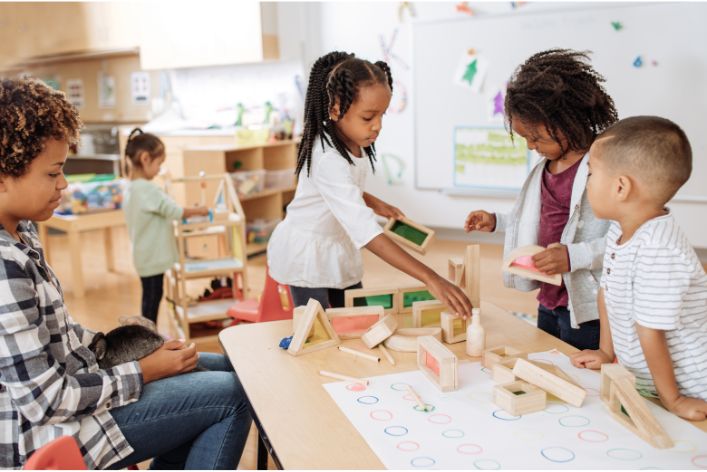Understanding Developmental Differences
Definitions
Developmental differences refer to variations in physical, cognitive, and emotional growth.
These differences can affect how individuals learn, communicate, and interact with others.
Every person experiences development uniquely, influenced by genetics and environment.
Types of Developmental Differences
There are several types of developmental differences.
- Intellectual disabilities impact learning abilities.
- Physical disabilities affect mobility and coordination.
- Emotional or behavioral disorders influence emotional regulation and social interactions.
Cognitive differences might impact problem-solving and processing speed.
It’s crucial to recognize the range of abilities across individuals.
Individual Variability
Each individual’s development is influenced by their unique experiences and circumstances.
For instance, twins may have differing strengths despite sharing genetics.
Understanding these variabilities helps in creating supportive environments.
Importance of Awareness
Awareness of developmental differences fosters empathy and acceptance.
It empowers communities to support individuals with varying needs.
Moreover, this understanding aids educators and caregivers in developing effective approaches.
Recognizing Signs of Developmental Differences in Children
Understanding Developmental Milestones
Developmental milestones serve as benchmarks for children’s growth.
Parents should familiarize themselves with these milestones.
These include language, motor skills, and social interaction.
Parenting Made Just for You
Get personalized Parenting Solutions tailored to your child’s needs. Transform your parenting journey with expert guidance in 1-3 days.
Get StartedTracking these milestones can reveal potential concerns.
Identifying Early Warning Signs
Some children may show delays in speech or language.
Others might struggle with social skills or emotional regulation.
Watch for signs of difficulty in coordinating movements.
Note if your child seems less engaged in play with peers.
Observing Emotional Responses
Children with developmental differences may react differently emotionally.
They might display heightened sensitivity to sensory input.
Additionally, they may have difficulty managing frustration.
Identifying these behaviors can help in understanding their needs.
Seeking Professional Guidance
If you notice any red flags, consider consulting professionals.
Early intervention can make a significant difference in outcomes.
Professionals can provide valuable insights and resources.
Stay proactive in seeking help if needed.
Connecting with Other Parents
Engaging with other parents can provide support and resources.
Unveil the Perfect Name that Tells Your Family's Story
Let us help you find a name that embodies your family's values, traditions, and dreams. Our personalized consultation weaves cultural insights to create a name that's uniquely yours.
Get StartedSharing experiences can reduce feelings of isolation.
Look for local support groups or online communities.
These networks often share helpful coping strategies.
The Importance of Early Detection and Intervention
Recognizing Developmental Differences
Early detection of developmental differences is crucial for effective support.
Recognizing these differences allows for timely interventions.
Children benefit most from support during their formative years.
In addition, it helps to identify specific needs and challenges.
Benefits of Timely Intervention
Timely intervention enhances a child’s development and learning potential.
This approach often leads to improved outcomes in various life areas.
Children receiving early help exhibit greater academic success.
Furthermore, early intervention fosters better social skills and emotional regulation.
Identifying Signs of Delay
Many signs can indicate a possible developmental difference.
Some common signs include delayed speech or language skills.
Other indicators may involve difficulties in social interactions.
Additionally, watch for challenges in motor skills or daily activities.
Collaborating with Professionals
Building a team with professionals enhances support efforts.
Collaboration with educators, therapists, and medical professionals is essential.
These experts can provide tailored strategies for individual needs.
Moreover, active communication with families strengthens intervention success.
Encouraging Parental Involvement
Parents play a crucial role in their child’s development.
Encouraging parental involvement fosters greater progress.
Parents can advocate for their child’s needs within educational settings.
Furthermore, they can implement supportive strategies at home.
Explore Further: Recognizing Emotional and Social Milestones in Nigerian Children
Building a Support System
Engaging with Professionals
Connecting with qualified professionals is vital for addressing developmental differences.
Consider seeking guidance from psychologists, therapists, or educators.
These experts can provide tailored strategies for your unique situation.
Also, don’t hesitate to approach specialists who specialize in specific developmental areas.
For instance, occupational therapists can assist with sensory processing issues.
Speech-language pathologists can help with communication challenges.
Consulting professionals ensures that you receive accurate diagnoses and effective interventions.
Joining Community Support Groups
Finding a community support group can foster personal connections.
Support groups allow you to share experiences and learn from others.
Look for local or online groups focused on developmental differences.
Engaging in these communities enhances your understanding and coping strategies.
Sharing insights with others can provide emotional support and validation.
Participating in Workshops and Seminars
Workshops and seminars can equip you with useful information.
Look for events that focus on developmental differences and support strategies.
These opportunities often feature expert speakers sharing valuable insights.
Attending such sessions allows you to network with other caregivers and professionals.
Furthermore, they provide practical tools you can implement immediately.
Utilizing Online Resources
The internet offers a wealth of information about developmental differences.
Many reputable organizations provide articles, videos, and forums on the subject.
Engage with online communities dedicated to specific developmental conditions.
These resources can provide new perspectives and coping mechanisms.
Additionally, you can find educational materials suitable for all age groups.
Discover More: How to Recognize and Support Delayed Milestones in Nigerian Children
Effective Communication Strategies with Children Affected by Developmental Differences
Understanding the Unique Needs
Each child has unique developmental needs.
Recognizing these needs fosters better communication.
Listen carefully to their verbal and non-verbal signals.
This attention allows you to respond appropriately.
Using Clear and Simple Language
Clear language enhances understanding for all children.
Avoid using complex vocabulary and jargon.
Opt for simple, direct sentences instead.
Furthermore, using visual aids can clarify your message.
Practicing Patience and Flexibility
Patience is crucial when communicating with children.
Allow children extra time to process information.
Be prepared to repeat or rephrase your points.
Flexibility helps to adapt to their immediate needs.
Encouraging Participation and Engagement
Encourage children to express themselves freely.
Ask open-ended questions to stimulate conversation.
This practice promotes a sense of belonging and value.
Additionally, provide positive feedback to boost confidence.
Developing Non-Verbal Communication Skills
Non-verbal cues play a significant role in communication.
Use gestures, facial expressions, and body language.
Children often respond well to visual inputs.
Moreover, maintaining eye contact fosters connection.
Creating a Safe and Supportive Environment
A supportive environment encourages open communication.
Ensure the space feels safe for self-expression.
This approach helps children feel valued and understood.
Furthermore, being consistent builds trust over time.
See Related Content: Understanding Cognitive Development Milestones in Nigerian Children

Fostering a Growth Mindset in Children
Understanding Growth Mindset
A growth mindset is essential for resilience and independence.
This mindset emphasizes effort and learning over innate ability.
Encouraging children to embrace challenges reinforces this perspective.
Encouraging Resilience
Resilience helps children cope with setbacks and failures.
Parents and educators can model resilient behaviors.
Share personal stories of overcoming difficulties.
Teach children to see failures as learning opportunities.
Provide them with coping strategies for handling stress.
Building Independence
Independence fosters self-confidence and decision-making skills.
Allow children to take on age-appropriate responsibilities.
Encourage them to solve problems independently before seeking help.
Support their choices, even if they lead to mistakes.
Provide a safe space for them to express their thoughts and feelings.
Practical Strategies
- Provide positive reinforcement for effort and persistence.
- Create an environment that celebrates learning, not just success.
- Use language that encourages growth and effort.
- Engage with them in goal-setting exercises.
- Encourage open discussions about challenges and solutions.
Discover More: Tracking and Supporting Nigerian Children’s Growth Milestones Effectively
Navigating Educational Resources and Options for Diverse Learning Needs
Understanding Individual Learning Differences
Learning differences can vary significantly among individuals.
Examples include dyslexia, ADHD, and autism spectrum disorders.
Recognizing these differences is the first step toward effective support.
Early identification can lead to appropriate interventions.
Additionally, working closely with educators can provide insights.
Exploring Educational Options
Numerous educational resources are available for students with diverse needs.
Public schools often provide special education services.
Under the Individuals with Disabilities Education Act, students are entitled to tailored support.
Parents should explore Individualized Education Programs (IEPs) for specific accommodations.
Private schools also offer specialized programs to support various learning styles.
Utilizing Community Resources
Community organizations can be valuable for educational resources.
Local nonprofits may offer tutoring services and workshops.
Support groups connect parents with shared experiences.
Furthermore, libraries host educational events and programs.
Online platforms provide access to various learning materials.
Incorporating Technology in Learning
Technology presents new opportunities for diverse learners.
Educational apps cater to different learning preferences and styles.
For example, interactive software can enhance engagement.
Assistive technology can aid communication and learning.
Additionally, online courses offer flexible learning environments.
Fostering Advocacy and Communication
Advocacy plays a vital role in navigating educational challenges.
Parents must learn to effectively communicate their child’s needs.
Establishing relationships with educators builds a supportive network.
Participating in school meetings ensures parents are heard.
Moreover, understanding parents’ rights empowers families.
Monitoring Progress and Adjusting Strategies
Regular assessments help track a child’s development.
Feedback from teachers provides valuable insights into progress.
Adjustments to learning strategies may be necessary over time.
Collaboration with education professionals ensures effective solutions.
Ultimately, ongoing support fosters student confidence and success.
Promoting Inclusivity: How to Advocate for Your Child in Social Settings
Understanding Your Child’s Needs
Every child has unique developmental differences.
Recognizing these needs enhances effective advocacy.
Additionally, understanding them builds confidence in interactions.
Creating a Positive Environment
A supportive environment encourages open communication.
Invite friends and peers to join activities together.
Also, provide opportunities for social interaction regularly.
Using Clear Communication
Clearly explain your child’s needs to others.
Use simple language and relatable examples.
This approach fosters understanding among peers and adults.
Encouraging Peer Engagement
Guide group activities to include your child seamlessly.
Encourage empathy and inclusion among their peers.
Furthermore, promote shared interests to strengthen connections.
Addressing Challenges Directly
Approach any conflicts proactively and constructively.
Discuss the situation privately with relevant individuals.
This transparency cultivates respect and understanding.
Building a Supportive Network
Connect with other parents for shared experiences.
Support groups can provide additional resources and advice.
Additionally, consider local organizations that focus on inclusivity.
Additional Resources
Reviewing the evidence on how teacher professional development …
The effects of social deprivation on adolescent development and …




